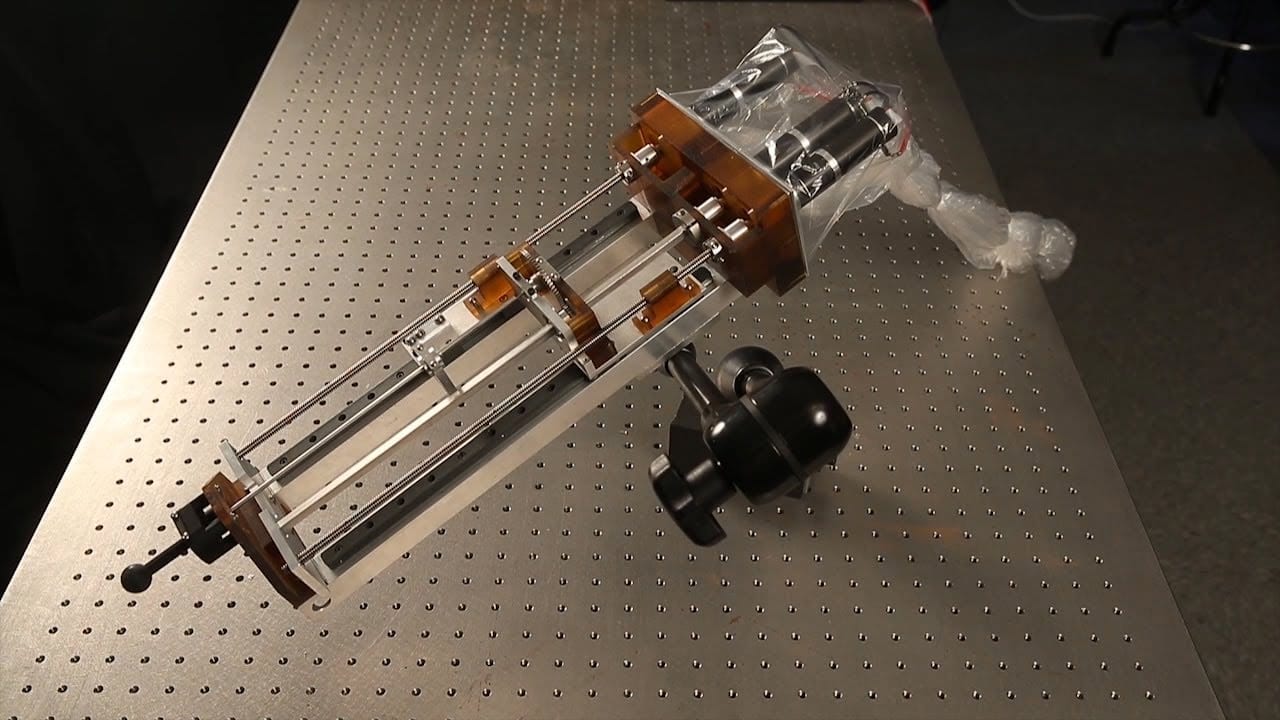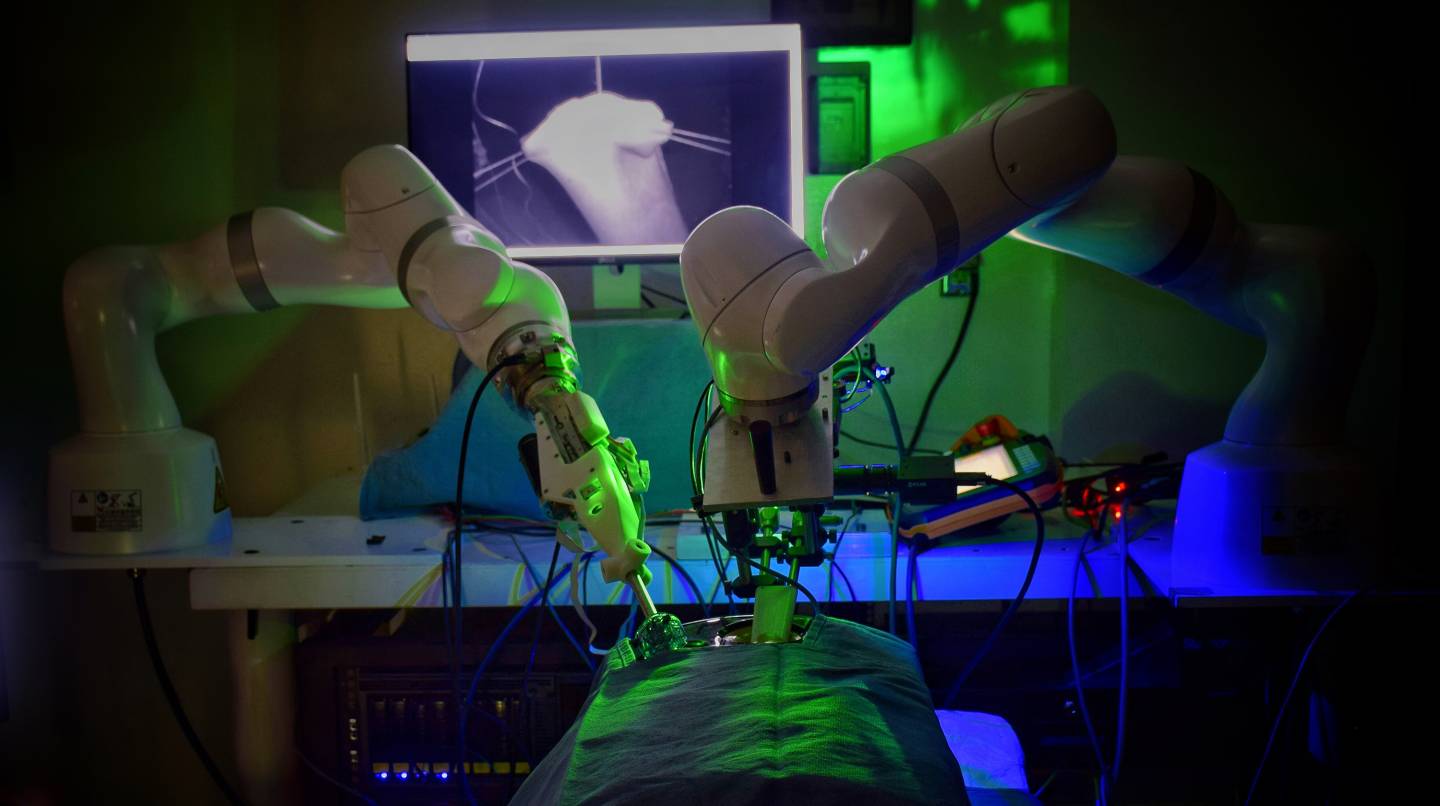 Surgery to relieve the damaging pressure caused by hemorrhaging in the brain is a perfect job for a robot.
Surgery to relieve the damaging pressure caused by hemorrhaging in the brain is a perfect job for a robot.
That is the basic premise of a new image-guided surgical system under development at Vanderbilt University. It employs steerable needles about the size of those used for biopsies to penetrate the brain with minimal damage and suction away the blood clot that has formed.
The system is described in an article accepted for publication in the journal IEEE Transactions on Biomedical Engineering. It is the product of an ongoing collaboration between a team of engineers and physicians headed by Assistant Professor Robert J. Webster III and Assistant Professor of Neurological Surgery Kyle Weaver.
Brain clots are leading cause of death, disability
The odds of a person getting an intracerebral hemorrhage are one in 50 over his or her lifetime. When it does occur, 40 percent of the individuals die within a month. Many of the survivors have serious brain damage.
“When I was in college, my dad had a brain hemorrhage,” said Webster. “Fortunately, he was one of the lucky few who survived and recovered fully. I’m glad I didn’t know how high his odds of death or severe brain damage were at the time, or else I would have been even more scared than I already was.”
Steerable needle could prevent “collateral damage” during surgery
Operations to “debulk” intracerebral hemorrhages are not popular among neurosurgeons: They know their efforts are not likely to make a difference, except when the clots are small and lie on the brain’s surface where they are easy to reach. Surgeons generally agree that there is a clinical benefit from removing 25-50 percent of a clot but that benefit can be offset by the damage that is done to the surrounding tissue when the clot is removed. Therefore, when a serious clot is detected in the brain, doctors take a “watchful waiting” approach – administering drugs that decrease the swelling around the clot in hopes that this will be enough to make the patient improve without surgery.
For the last four years, Webster’s team has been developing a steerable needle system for “transnasal” surgery: operations to remove tumors in the pituitary gland and at the skull base that traditionally involve cutting large openings in a patient’s skull and/or face. Studies have shown that using an endoscope to go through the nasal cavity is less traumatic, but the procedure is so difficult that only a handful of surgeons have mastered it.
Last summer, Webster attended a conference in Italy where one of the speakers, Marc Simard, a neurosurgeon at the University of Maryland School of Medicine, ran through his wish list of useful imaginary neurosurgical devices, hoping that some engineer in the audience might one day be able to build one of them. When he described his wish to have a needle-sized robot arm to reach deep into the brain to remove clots, Webster couldn’t help smiling because the steerable needle system he had been developing was perfect for the job.
Webster’s design, which he calls an active cannula, consists of a series of thin, nested tubes. Each tube has a different intrinsic curvature. By precisely rotating, extending and retracting these tubes, an operator can steer the tip in different directions, allowing it to follow a curving path through the body. The single needle system required for removing brain clots was actually much simpler than the multi-needle transnasal system.
I think this can save a lot of lives.When Webster returned, he told Weaver about the potential new application. The neurosurgeon was quite supportive: “I think this can save a lot of lives.There are a tremendous number of intracerebral hemorrhages and the number is certain to increase as the population ages.”
Graduate student Philip Swaney, who is working on the system, likes the fact it is closest to commercialization of all the projects in Webster’s Medical and Electromechanical Design Laboratory. “I like the idea of working on something that will begin saving lives in the very near future,” he said.
The Latest Bing News on:
Robot Brain Surgery
- Everything you need to know about hysterectomieson April 30, 2024 at 5:00 am
While the advent of keyhole surgery has made the procedure faster and minimally invasive, the decision to have one should not be taken lightly. “By the time women have got to the point of thinking ...
- AI Use Grows at Hospitalson April 29, 2024 at 12:01 am
No longer just characters in your favorite science fiction thriller, robots and artificial intelligence are already playing an increasingly significant role at local hospitals.
- Local robotic surgeon hits major milestone of 1,500 caseson April 28, 2024 at 2:02 am
They decided to move things up a decade or so, and searched for a position — where he could again do robotic surgery — in the Commonwealth. He and his wife picked Spotsylvania Regional Medical Center, ...
- Men Who Couldn't Keep It In Their Pants Spill The Beans On How Their Relationships Changed For Better Or Worseon April 27, 2024 at 2:15 am
If you or someone you know is in immediate danger as a result of domestic violence, call 911. For anonymous, confidential help, you can call the 24/7 National Domestic Violence Hotline at ...
- HMC successfully manages doing first robotic kidney transplant in Qataron April 27, 2024 at 1:12 am
Hamad Medical Corporation (HMC) succeeded in performing the first robotic kidney transplant surgery in Qatar for a patient in his seventies.The patient ...
- Soft robotic nerve cuffs could revolutionize treatment of neurological conditionson April 26, 2024 at 5:49 pm
Researchers have developed tiny, flexible devices that can wrap around individual nerve fibres without damaging them.
- ACIBADEM Launches Online Second Medical Opinion Initiative, Revolutionizing Medicla Online Consultationson April 26, 2024 at 10:53 am
ACIBADEM Hospitals is a premier Turkey-based provider of full-spectrum healthcare services with an international scope of operations. The ...
- HMC Succeeds In Performing First Robotic Kidney Transplant In Qataron April 24, 2024 at 6:00 am
Hamad Medical Corporation succeeded in performing the first robotic kidney transplant surgery in Qatar for a patie ...
- MIT Technology Reviewon April 19, 2024 at 3:00 am
In the world of brain-computer interfaces, it can seem as if one company sucks up all the oxygen in the room. Last month, Neuralink posted a video to X showing the first human subject to receive its ...
- Brain chip development occurs at the expense of disabled peopleon April 17, 2024 at 7:16 pm
Additionally, the company has not positioned their BCIs to complement traditional and low-cost support systems or accommodations available to quadriplegic people, such as accessible public ...
The Latest Google Headlines on:
Robot Brain Surgery
[google_news title=”” keyword=”Robot Brain Surgery” num_posts=”10″ blurb_length=”0″ show_thumb=”left”]
The Latest Bing News on:
Image-guided surgical system
- Advanced imaging to navigate the nervous systemon April 29, 2024 at 9:49 pm
It is synonymous with image-guided and computer-aided surgery ... The surgeon utilises this navigation system to guide the surgical instruments to the intended target with high precision.
- New NICO Myriad SPECTRA™ System Launching at Annual Neurosurgeon Meeting in Chicagoon April 25, 2024 at 10:53 am
Medical device innovator and worldwide leader in minimally invasive neurosurgery NICO Corporation is launching its latest product innovation at next week's American Association of Neurosurgical ...
- Philips' Zenition 30 to Boost Image-Guided Surgerieson April 23, 2024 at 1:32 pm
The approval is likely to make image-guided surgical procedures available to more patients at ... The company also announced the launch of its new Azurion neuro biplane system, which is likely to be a ...
- Philips' (PHG) Zenition 30 to Boost Image-Guided Surgerieson April 23, 2024 at 7:44 am
The approval is likely to make image-guided surgical procedures available to ... announced the launch of its new Azurion neuro biplane system, which is likely to be a major improvement in its ...
- Philips' (PHG) Zenition 30 to Boost Image-Guided Surgerieson April 23, 2024 at 3:44 am
The approval is likely to make image-guided surgical procedures available to more patients at ... The company also announced the launch of its new Azurion neuro biplane system, which is likely to be a ...
- PRCT PROCEPT BioRobotics Corporationon April 22, 2024 at 10:29 pm
The company develops, manufactures, and sells AquaBeam Robotic System, an image-guided, surgical robotic system for use in minimally invasive urologic surgery with a focus on treating benign ...
- META Dynamic Inc. Enters Strategic Partnership with Omniscient Neurotechnology to Distribute Quicktome™ Brain-Mapping Softwareon April 16, 2024 at 7:27 am
META, recognized for its OSS program, optimizes image-guided surgery with expert clinical case support and CBYON Eclipse navigation system rental options. These offerings enhance operating room ...
- Humans are the nuts and bolts of RIT robotics researchon April 12, 2024 at 11:48 am
At RIT, student and faculty researchers take a human-centered approach to robotics in order to improve communication between robots and people.
- PROCEPT BioRobotics Corp.on June 3, 2022 at 8:11 am
It manufactures and sells the AquaBeam Robotic System, an image-guided, surgical robotic system for use in minimally invasive urologic surgery, with an initial focus on treating BPH. The firm's ...
- Safety in fluoroscopy guided interventional procedureson February 1, 2022 at 8:47 am
In recent years, minimally invasive medical interventions performed under fluoroscopy and other types of imaging guidance have been extensively replacing the open surgery for many medical ...
The Latest Google Headlines on:
Image-guided surgical system
[google_news title=”” keyword=”image-guided surgical system” num_posts=”10″ blurb_length=”0″ show_thumb=”left”]










